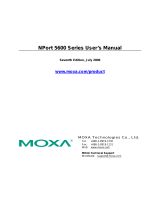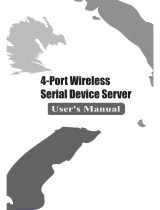
UDP Mode............................................................................................................ 5-23
Pair Connection Mode .......................................................................................... 5-25
Reverse Telnet Mode............................................................................................ 5-27
Disabled Mode...................................................................................................... 5-28
RFC2217 Mode..................................................................................................... 5-28
PPP Mode ............................................................................................................. 5-30
Accessible IP Settings...................................................................................................... 5-31
PPP User Table................................................................................................................. 5-32
Auto Warning Settings ..................................................................................................... 5-33
Auto warning: E-mail and SNMP Trap................................................................. 5-33
Event Type............................................................................................................ 5-34
Monitor............................................................................................................................. 5-36
Monitor Line......................................................................................................... 5-36
Monitor Async...................................................................................................... 5-36
Monitor Async-Settings........................................................................................ 5-37
Change Password............................................................................................................. 5-37
Load Factory Defaults...................................................................................................... 5-38
Chapter 6 Configuring NPort Administrator...........................................................6-1
Overview............................................................................................................................ 6-2
Installing NPort Administrator........................................................................................... 6-2
Configuration ..................................................................................................................... 6-5
Broadcast Search..................................................................................................... 6-6
Unlock Password Protection................................................................................... 6-7
Configuring NPort 5600........................................................................................ 6-10
Upgrading Firmware............................................................................................. 6-12
Export/Import........................................................................................................ 6-13
Monitor............................................................................................................................. 6-14
Port Monitor..................................................................................................................... 6-20
COM Mapping ................................................................................................................. 6-20
On-line COM Mapping......................................................................................... 6-21
Off-line COM Mapping........................................................................................ 6-25
IP Location....................................................................................................................... 6-26
Chapter 7 IP Serial LIB..............................................................................................7-1
Overview............................................................................................................................ 7-2
IP Serial LIB Function Groups........................................................................................... 7-3
Example Program............................................................................................................... 7-3
Appendix A Pinouts and Cable Wiring......................................................................A-1
Port Pinout Diagrams........................................................................................................ A-2
Ethernet Port Pinouts ............................................................................................. A-2
Serial Port Pinouts.................................................................................................. A-2
Cable Wiring Diagrams..................................................................................................... A-3
Ethernet Cables...................................................................................................... A-3
Serial Cables for NPort 5610/5650 (RS-232)......................................................... A-3
Serial Cables for NPort 5630 (RS-422/4-wire RS-485)......................................... A-5
Serial Cables for NPort 5630 (2-wire RS-485)...................................................... A-6
Serial Cables for NPort 5650 (RS-422/4-wire RS-485)......................................... A-7
Serial Cables for NPort 5650 (2-wire RS-485)...................................................... A-8
Pin Assignments for DB9 and DB25 Connectors.................................................. A-9
Appendix B Well Known Port Numbers ....................................................................B-1





























